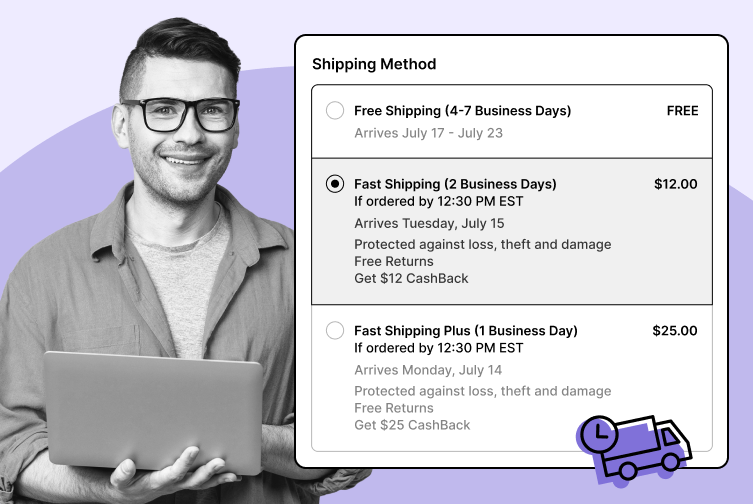
How to Offer Eco-Friendly Shipping in Ecommerce Without Losing Profit
Discover 7 essential tips for implementing eco-friendly shipping practices that boost your brand’s sustainability!
Shipping, Tracking & Notifications
Boost customer experience and reduce support tickets
Realtime order and shipment tracking
Proactive order and shipping notifications
AI-Enhanced Discounted Labels
Predictive pre-purchase estimated delivery dates
Self-Serivce branded order tracking
Effortless experience delivered
Identify and Resolve Order Issues
Realtime order and shipment tracking
Make returns profitable and delight customers
Flexibility to define any return destinations & conditions
Simplify returns for your customers and team
Incentivize exchanges over returns
Returns management made easy for your team
Returns management made easy for your team
Easy claims and smart upsells
Understand why your customers are returning
In-Store & Curbside Pickup
Unify the online and the in-store experience
Hassle-free pickup experience for customers
In-Store dashboard to keep operations streamlined
In-Store and Online orders unified
Drive foot-traffic to your stores
Shipping, Tracking & Notifications
Boost customer experience and reduce support tickets
Realtime order and shipment tracking
Proactive order and shipping notifications
AI-Enhanced Discounted Labels
Predictive pre-purchase estimated delivery dates
Self-Serivce branded order tracking
Effortless experience delivered
Identify and Resolve Order Issues
Realtime order and shipment tracking
Make returns profitable and delight customers
Flexibility to define any return destinations & conditions
Simplify returns for your customers and team
Incentivize exchanges over returns
Returns management made easy for your team
Returns management made easy for your team
Understand why your customers are returning
In-Store & Curbside Pickup
Unify the online and the in-store experience
Hassle-free pickup experience for customers
In-Store Dashboard to keep operations streamlined
In-Store and Online orders unified
Drive foot-traffic to your stores
Boost customer experience and reduce support tickets
Realtime order and shipment tracking
Proactive order and shipping notifications
AI-Enhanced Discounted Labels
Predictive pre-purchase estimated delivery dates
Self-Serivce branded order tracking
Effortless experience delivered
Make returns profitable and delight customers
Flexibility to define any return destinations & conditions
Simplify returns for your customers and team
Incentivize exchanges over returns
Returns management made easy for your team
Equip your team for precise return checks.
Easy claims and smart upsells
Understand why your customers are returning
Unify the online and the in-store experience
Hassle-free pickup experience for customers
In-Store Dashboard to keep operations streamlined
In-Store and Online orders unified
Drive foot-traffic to your stores
Find the answer to all your questions
Take a step by step trip through our functionality to see how we can improve your ecommerce processes.
Explore the most comon questions about WeSupply
Calculate the ROI that WeSupply can bring you
Read actionable articles on how to optimize your post-purchase experience and decrease support tickets
Get inspired by stories of how our customers implemented an effortless post-purchase experience
Wondering if WeSupply is a good fit for you? Read through our use cases to see how we can help you increase conversion & improve CX!
A Deep Dive into Top Companies' Order Tracking & Returns Strategy
Find the answer to all your questions
Explore the most comon questions about WeSupply
Calculate the ROI that WeSupply can bring you
Request a no strings attached review of your current shopping experience and missed conversion opportunities
Take a step by step trip through our functionality to see how we can improve your ecommerce processes.
Read actionable articles on how to optimize your post-purchase experience and decrease support tickets
Get inspired by stories of how our customers implemented an effortless post-purchase experience
A Deep Dive into Top Companies' Order Tracking & Returns Strategy
Wondering if WeSupply is a good fit for you? Read through our use cases to see how we can help you increase conversion & improve CX!

The ecommerce landscape is evolving faster than ever. Consumer expectations are rising, delivery windows are shrinking, and competition is intensifying. Amid these challenges, one factor can make or break your brand: shipping. A company’s choice of shipping solutions directly impacts long-term viability, operational efficiency, and customer satisfaction. It’s no longer just a back-end operation; it’s a crucial, customer-facing experience. And in today’s world, future-proofing your ecommerce shipping is less of a luxury and more of a necessity.
Future-proof shipping means building systems that are efficient, scalable, resilient, and customer-focused. To achieve this, businesses must embrace automation and data-driven strategies. As companies navigate the evolving landscape and rising expectations, they face the challenge of manual data extraction and analysis, which can hinder efficiency and decision-making automation addresses these challenges by streamlining processes. These tools not only streamline day-to-day operations but also provide the agility needed to adapt to changing demands and technologies. In this article, we’ll explore how to future-proof your ecommerce shipping by adopting automation and leveraging data to make smarter decisions at every stage.
Automation is the cornerstone of any future-ready ecommerce operation. As order volumes increase, manual processes become bottlenecks that slow growth and increase costs, often resulting in higher costs due to carrier rate increases, outdated shipping systems, and the financial impact of relying on single carriers. Automation eliminates these inefficiencies.
By automating core shipping tasks like order processing, label generation, and carrier selection, ecommerce businesses can fulfill orders faster and with fewer errors. For instance, software can automatically import order data from your ecommerce platform, select the optimal shipping method based on rules you define (like cost or delivery time), and print labels in bulk.
This also reduces the need for excessive staffing. Instead of hiring more workers to keep up with order growth, you can rely on smart automation to manage the load. That means more scalability without proportional overhead.
Moreover, automation minimizes human errors such as incorrect addresses or mislabeled packages issues that often lead to costly delays, returns, and frustrated customers. Automation serves as a comprehensive solution to the challenges of scaling shipping operations. When the system runs smoothly, your team can shift their focus from repetitive tasks to more strategic functions like customer service, product development, or expansion planning.
Efficient fulfillment starts with a well-run warehouse. Smart technologies such as robotics, AI, and IoT devices are revolutionizing warehouse operations and making it easier to scale while reducing errors and overhead.
Automated systems can handle picking, packing, and sorting with speed and precision. For example, robotics can navigate warehouse aisles to retrieve products, reducing human effort and accelerating fulfillment. AI can help determine the most efficient packing methods or even recommend packaging sizes to minimize material waste and shipping costs.
Warehouse Management Systems (WMS) play a vital role here. These platforms provide real-time inventory visibility, ensuring accurate stock levels and faster decision-making. Robust integration capabilities with other business software are essential, as they enable seamless data flow, reduce manual errors, and improve overall operational efficiency. Smart WMS tools can also automate reordering when inventory drops below a certain threshold, reducing the risk of stockouts or overstocking.
IoT-enabled sensors add another layer of intelligence, monitoring storage conditions such as temperature and humidity critical for certain products like perishables or electronics. These innovations collectively create a warehouse environment that supports speed, accuracy, and sustainability.
Efficient document management is a cornerstone of future-proofing your ecommerce shipping operations. Manual data entry and paper-based processes are not only time consuming but also prone to human error, leading to costly mistakes and delays. By adopting automation solutions, businesses can transform document management from a pain point into a source of competitive edge.
Automation software seamlessly integrates with existing systems, such as warehouse management systems, to digitize and streamline the handling of shipping documentation, packing lists, invoices, and customer information. This integration eliminates repetitive manual data entry, reduces labor costs, and ensures that critical documents are always accurate and accessible in real time. As a result, companies can optimize operations, improve delivery speed, and meet rising customer expectations for transparency and efficiency.
Moreover, automated systems provide valuable insights into inventory levels and shipping processes, allowing businesses to make data-driven decisions that enhance operational efficiency and customer satisfaction. For example, machine learning algorithms can analyze historical data to predict supply chain disruptions such as those caused by climate change and recommend proactive measures to mitigate their impact. This level of agility helps companies stay ahead of challenges and remain resilient in a rapidly changing market.
By embracing technology and automating business processes, ecommerce companies not only save valuable time but also build strong relationships with customers through accurate, timely communication and reliable service. Streamlined document management is more than an operational upgrade it’s a strategic move toward long-term success and future-proofing your business.
Shipping doesn’t end when a package leaves the warehouse it continues through the customer’s inbox and tracking screen. That’s why automating customer communication is essential for building trust and loyalty.
Automated systems can send timely updates for each shipping milestone: order confirmation, shipping confirmation, out-for-delivery notifications, and delivery confirmation. These updates reduce the need for customers to reach out with questions and create a sense of transparency.
You can also use AI-powered chatbots to manage customer inquiries related to shipping and returns. These tools are especially helpful during peak seasons when support teams are stretched thin. Chatbots can instantly provide tracking information, expected delivery times, or guidance on return procedures.
When customers feel informed and empowered throughout the shipping process, they’re more likely to return for future purchases even if something goes wrong along the way. Communication builds confidence. Automating customer communication helps improve customer satisfaction by ensuring timely and accurate updates at every stage.
In a future-proof shipping strategy, data is your compass. It helps you understand what’s working, where improvements are needed, and how to make informed decisions that align with your business goals.
Start by identifying and monitoring key performance indicators (KPIs) such as order accuracy, processing time, shipping costs, carrier performance, and customer satisfaction scores. With the right dashboards and reporting tools, you can track these metrics in real time. Extracting actionable insights from shipping data enables smarter decision-making and proactive problem-solving, helping you optimize operations more effectively.
Use this data to uncover bottlenecks. For example, are certain shipping methods consistently delayed? Are returns more common with specific products? These insights allow you to make targeted improvements that enhance efficiency and reduce costs.
Demand forecasting is another powerful application of data. By analyzing historical sales patterns, seasonality, and external factors (like holidays or promotions), you can predict when order volumes will spike and proactively manage staffing and inventory.
Additionally, data helps with warehouse layout and inventory placement. Placing bestsellers closer to packing stations, for example, reduces handling time. These small changes, informed by data, add up to big performance gains.
AI and machine learning (ML) bring powerful capabilities to ecommerce shipping especially when it comes to optimizing last-mile delivery and choosing the best carrier for each shipment.
AI algorithms can evaluate real-time factors like traffic, weather, and package size to generate the most efficient delivery routes. This saves on fuel costs, shortens delivery times, and improves environmental sustainability.
Carrier selection is another area ripe for optimization. With automation and historical performance data, AI can recommend the best carrier based on price, speed, reliability, or even delivery success rates in specific regions.
By letting data guide routing and carrier decisions, ecommerce businesses can ensure timely, cost-effective deliveries while maintaining high customer satisfaction. Leveraging these technologies is essential to remain competitive in a rapidly evolving marketplace.
Customer expectations are at an all-time high, and your shipping strategy plays a huge role in meeting them. Automation and data make it possible to deliver a consistent, delightful post-purchase experience.
One major improvement is real-time tracking. By offering live updates and accurate delivery ETAs, you eliminate the anxiety of the unknown. Customers feel in control, which strengthens their trust in your brand.
You can also tailor shipping options based on customer behavior and order history. For instance, VIP customers might be offered free expedited shipping, while eco-conscious shoppers can opt into green delivery methods.
Returns management is another opportunity to enhance experience. Automated return portals, pre-generated labels, and tracking updates simplify the process for both customers and your team. Automating invoice management and returns processes not only streamlines operations but also plays a key role in enhancing customer satisfaction by improving efficiency and accuracy. Plus, analyzing return data helps reduce future returns by identifying problematic SKUs or inaccurate product descriptions.
A future-ready ecommerce shipping strategy depends on technology that can grow with your business. That means choosing flexible tools and integrations that allow you to adapt quickly. It’s also essential to evaluate your existing workflows to identify inefficiencies, pain points, and bottlenecks that automation can address for improved efficiency.
Look for platforms and software that support multi-channel selling and can sync with your ecommerce store, WMS, ERP, and carrier accounts. API connectivity is key to streamlining workflows and avoiding data silos.
If you’re growing rapidly or expanding internationally, third-party logistics (3PL) providers can offer scalability without the need to invest in new warehouses or teams. Many 3PLs come equipped with their own automation and analytics systems, giving you access to advanced tools without heavy upfront investment.
Just as important as the tools are the people using them. Invest in training and upskilling your staff so they can manage new systems and interpret data effectively. The right technology, in the right hands, can unlock tremendous value.
Future-proofing isn’t just about speed and cost it’s also about responsibility. As consumers grow more eco-conscious, sustainable shipping practices are becoming a business imperative.
Start with eco-friendly packaging. Use recyclable, compostable, or reusable materials and eliminate excess void fill. Smart packing algorithms can help select the most efficient box sizes, reducing dimensional weight charges and waste.
Next, consider carbon offset programs and green delivery options. Many carriers now offer carbon-neutral shipping services, and you can display these at checkout for environmentally minded customers.
Optimizing delivery routes with AI also contributes to sustainability by reducing fuel consumption and emissions. For urban deliveries, electric vehicles or bike couriers may be viable options.
Sustainability is no longer a niche concern it’s a competitive advantage. Brands that prioritize it will earn loyalty from customers who care about their environmental footprint.
Transitioning to automated systems can be a challenging journey, especially for businesses with established workflows and legacy systems. However, overcoming these hurdles is essential for future proofing your shipping operations and ensuring long-term business success.
The first step is to identify the pain points in your current processes such as manual processing, high labor costs, and frequent errors by leveraging data analytics. Pinpointing the most time-consuming and error-prone tasks in your shipping operations allows you to prioritize automation efforts where they will have the greatest impact. For example, automating the integration between your shipping software and accounting systems can drastically reduce manual data entry and improve cash flow management.
Selecting the right automation solutions is crucial. Look for tools that can integrate with your existing systems and scale as your business grows. Flexible automation software should support your current workflows while offering the adaptability needed to respond to evolving consumer expectations and market demands. Consider the potential ROI, including reduced labor costs, improved efficiency, and enhanced customer satisfaction, to ensure your investment delivers measurable value.
A phased approach to implementation helps ensure a smooth transition, minimizing disruptions to daily operations. Start with high-impact areas, monitor progress using key performance indicators such as processing time, error rates, and customer satisfaction, and make adjustments as needed. Continuous improvement is key regularly review your automated systems to identify new opportunities for optimization and cost reduction.
By embracing automation and committing to ongoing refinement, businesses can reduce costs, save valuable time, and gain a competitive edge. Automated systems not only streamline operations but also provide real-time visibility into shipping processes, enabling swift, informed decision-making. This agility ensures your business remains resilient and ready to meet the challenges of the future, no matter how consumer expectations or market conditions evolve.
Keep your customers engaged during the delivery experience
Book a quick call with our experts to see how WeSupply can help you engage your customers with relevant updates through the right channel, at the right time.
In today’s ecommerce world, fast, transparent, and scalable shipping isn’t just a nice-to-have it’s a competitive advantage. With customer expectations rising and shipping complexities growing, future-proofing your operations is more urgent than ever.
WeSupply helps you do exactly that by turning post-purchase chaos into clarity through powerful automation and real-time insights. Whether you’re battling delayed shipments, inefficient communication, or a lack of visibility, WeSupply gives you the tools to streamline your shipping process from checkout to doorstep (and even returns).
Here’s how WeSupply helps ecommerce brands ship smarter and scale faster:
View the entire order journey, from processing to delivery and return
Get real-time updates on shipping status across multi-shipments and dropshippers
Instantly identify unfulfilled orders and delivery milestones with clear, centralized tracking
Automate alerts for bad weather, carrier stalls, or lost/stolen packages
Take action on Return to Sender issues with proactive notifications
Handle undeliverable shipments early to prevent return-to-sender penalties
Identify and resolve failed delivery attempts or stalled shipments before they escalate
Reduce WISMO (“Where is my order?”) tickets and protect customer trust
Send bulk messages to customers affected by delivery issues or product delays
Use pre-built, branded tracking pages to answer questions before they’re asked
Improve CSAT and reduce support tickets with real-time updates customers love
Offer self-service return portals with pre-generated shipping labels
Instantly resolve lost or stolen package claims through branded pages
Convert returns into exchanges to protect revenue and increase customer loyalty
Use performance data to analyze carrier reliability, spot problem SKUs, or optimize fulfillment times
Forecast demand spikes using order history, delivery performance, and seasonal trends
Plug into Shopify, Magento, BigCommerce, and more
API connectivity ensures smooth data flow across systems
Launch in as little as 15 minutes and go live as soon as tomorrow
Support from WeSupply’s post-purchase experts to help you scale confidently
WeSupply doesn’t just track packages it transforms your entire post-purchase experience. With automation, data, and proactive tools at your fingertips, you’ll reduce costs, boost customer satisfaction, and make smarter shipping decisions every step of the way.
WeSupply doesn’t just track packages it transforms your entire post-purchase experience. With automation, data, and proactive tools at your fingertips, you’ll reduce costs, boost customer satisfaction, and make smarter shipping decisions every step of the way.
👉 Ready to future-proof your ecommerce shipping? Schedule a free demo today and launch smarter operations as soon as tomorrow.
Combat inconvenience with proactivity & self service
Book a quick call with our experts to see how WeSupply can help you make returns easy for your customers with a beautiful, self-service solution that makes their experience easier while also providing new ways to lower costs and earn back revenue.
The shipping landscape will continue to evolve, and staying ahead means keeping an eye on emerging trends.
Drone and autonomous vehicle deliveries are on the horizon, with major retailers already piloting these technologies. They promise faster, cheaper delivery for urban areas and hard-to-reach zones.
Hyper-personalized shipping experiences are also gaining traction. From customizable delivery windows to subscription-based replenishments, customers expect more tailored options.
Blockchain is another area to watch. It offers transparent, tamper-proof shipping records particularly useful for international logistics and high-value goods.
Lastly, micro-fulfillment centers and ship-to-store models are helping businesses meet same-day delivery demands. By storing inventory closer to customers, you can reduce last-mile costs and delivery times.
Keeping pace with these innovations will ensure your business remains agile and competitive in the years to come.
Shipping is no longer just a backend task it’s a powerful growth driver. With automation and real-time data, ecommerce brands can turn logistics into a competitive edge.
Platforms like WeSupply make this transformation easier than ever, offering real-time visibility across 1,000+ carriers, automated notifications via email and SMS, and proactive delay management to reduce WISMO tickets and avoid negative reviews. You can resolve lost or undeliverable shipments faster, streamline returns with self-service portals, and use advanced analytics to optimize carrier selection, packaging, and fulfillment speed.
Even better, WeSupply’s easy integrations and 15-minute onboarding mean you can start future-proofing your shipping as early as tomorrow. When automation and data work together, your operations become scalable, agile, and customer-focused.
The smartest brands are already investing in post-purchase innovation not just to meet today’s expectations, but to thrive in tomorrow’s market. Now’s the time to ship smarter and turn logistics into lasting customer loyalty.
1. What does it mean to future-proof ecommerce shipping?
Future-proofing ecommerce shipping means using automation and data to create scalable, efficient, and resilient logistics that adapt to changing demands, improve customer satisfaction, and reduce operational costs.
2. How can automation improve ecommerce shipping efficiency?
Automation speeds up order processing, reduces manual errors, optimizes carrier selection, and minimizes labor costs leading to faster, more reliable deliveries and better customer experiences.
3. Why is data important for ecommerce shipping decisions?
Data enables businesses to analyze carrier performance, delivery times, shipping costs, and customer behavior to make smarter decisions, avoid delays, and reduce returns.
4. How does WeSupply help reduce shipping-related support tickets?
WeSupply automates email and SMS notifications and proactively alerts customers to delays, reducing WISMO inquiries and support team workload.
5. What integrations does WeSupply support?
WeSupply integrates with Shopify, BigCommerce, Magento, WMS, ERP, and over 1,000 global carriers. Onboarding takes as little as 15 minutes.
6. Can WeSupply improve return management for ecommerce?
Yes. WeSupply offers self-service return portals, automated labels, and real-time tracking to streamline returns and convert them into exchanges for higher revenue retention.
7. Does WeSupply have an Official Shopify App?
Yes. WeSupply has an Official Shopify App. You can download it and start integrating with your Shopify Store.
8. Does WeSupply have an official Magento extension?
Yes, WeSupply has an official extension for Magento. The WeSupply x Magento integration allows for automating order tracking experiences, reducing customer inquiries, automating shipping email and SMS notifications, and providing a fully branded order tracking experience
9. Does WeSupply have an official BigCommerce App?
Yes, WeSupply has an official BigCommerce App. You can integrate WeSupply with your BigCommerce store to improve your post-purchase customer experience.
Learn How To Create Successful Post Purchase Email Campaigns
Build an effective post-purchase email flow that helps you increase customer satisfaction and drive revenue growth!

Discover 7 essential tips for implementing eco-friendly shipping practices that boost your brand’s sustainability!

Discover how AI-powered eCommerce shipping solutions can streamline operations and boost customer satisfaction!

Explore the key shipping trends shaping logistics in 2025. Gain insights to navigate challenges and seize opportunities!

Discover how poor shipping practices can impact your profits. Learn effective strategies to enhance your logistics and protect your bottom line. Read more!

Discover effective shipping optimization strategies to lower return rates and costs. Enhance your logistics today!

Explore how shipping affects customer satisfaction and loyalty. Understand the key factors that influence their experience. Read the article to learn more.

Learn how dynamic shipping rates at checkout can enhance pricing strategies and improve customer satisfaction. Discover practical tips in our article.

Effective strategies for communicating shipping delays to keep customers informed and satisfied. Enhance your customer service approach!

Discover effective strategies to manage split shipments, reduce delays, and enhance customer satisfaction. Practical solutions!